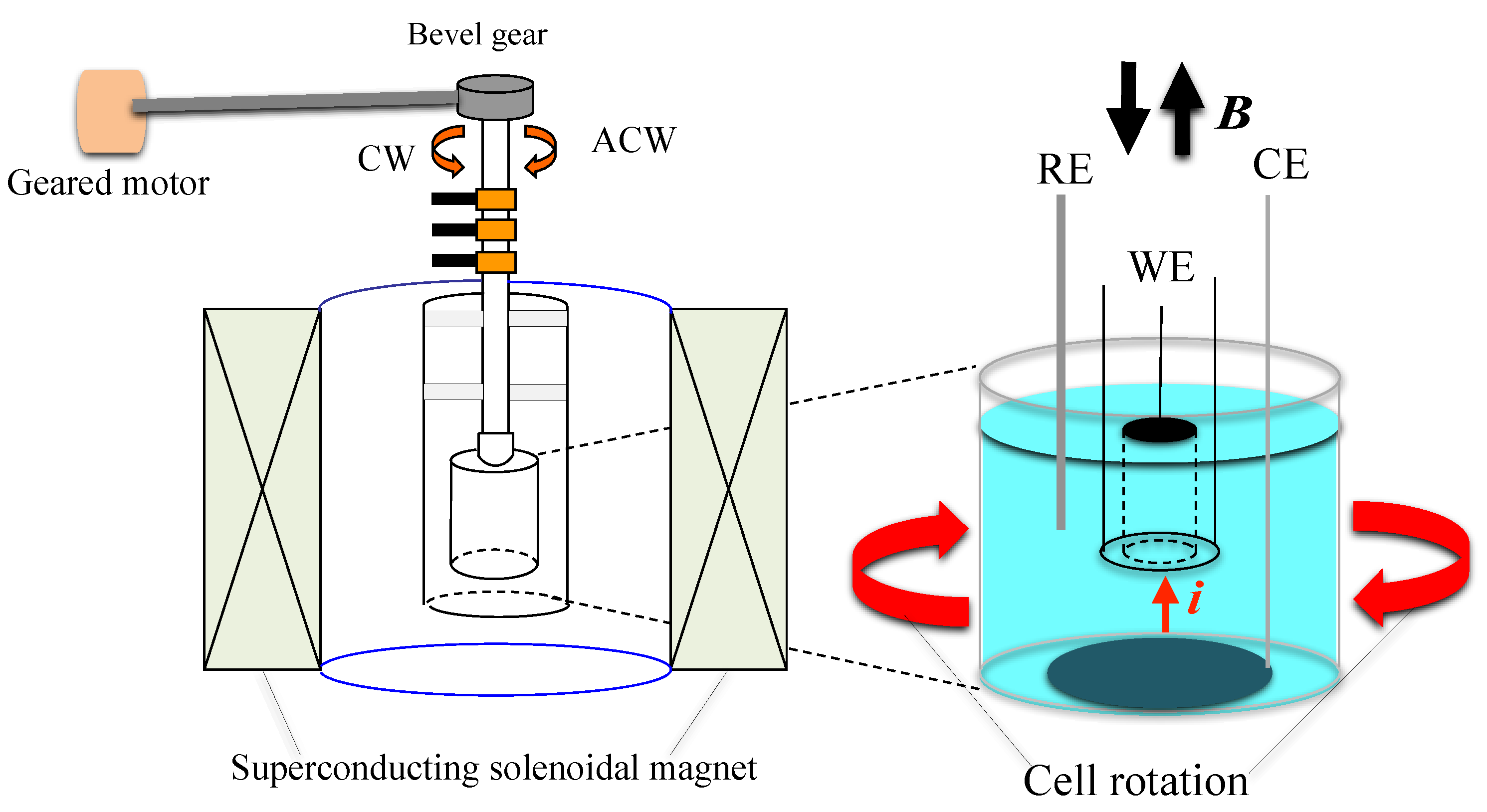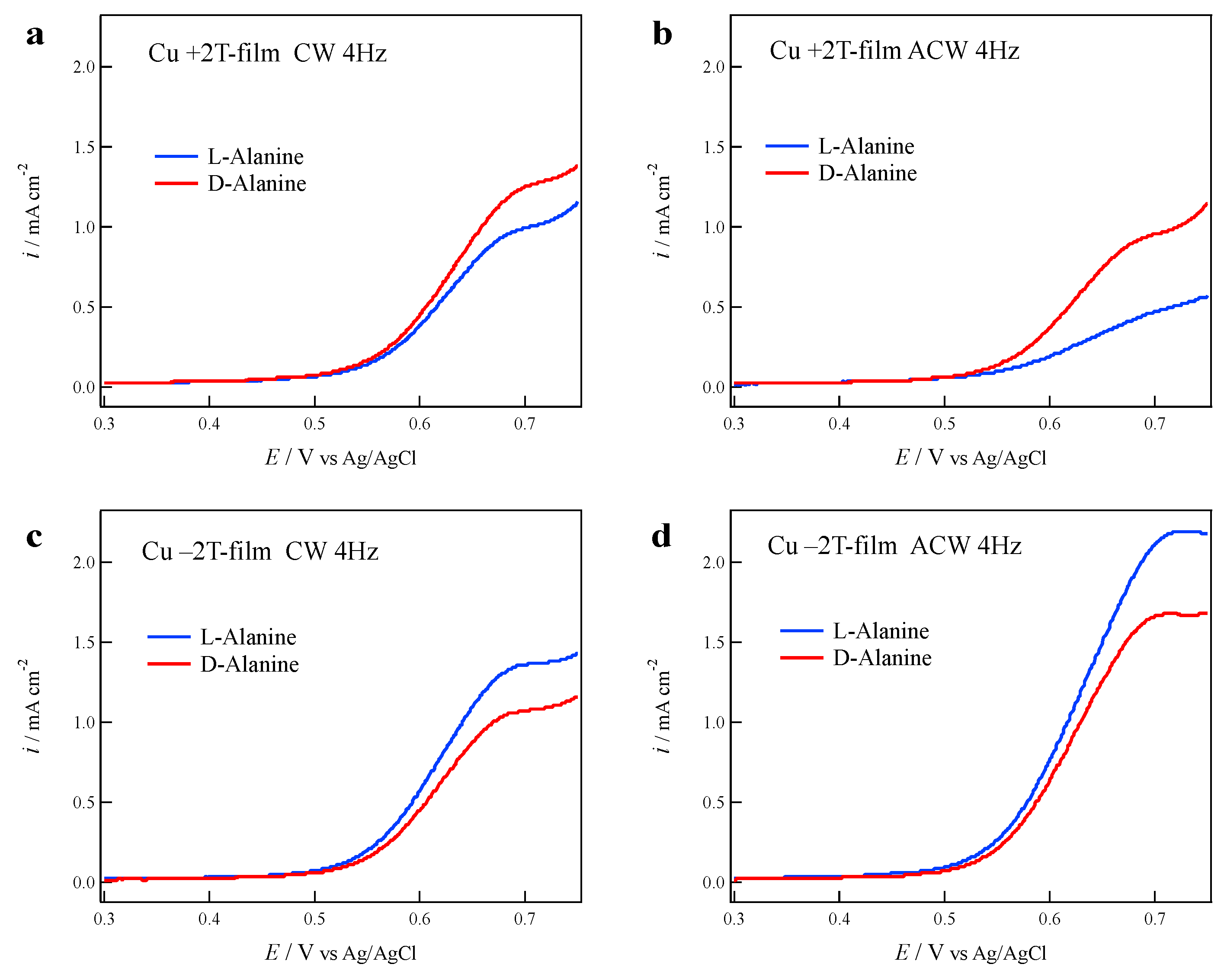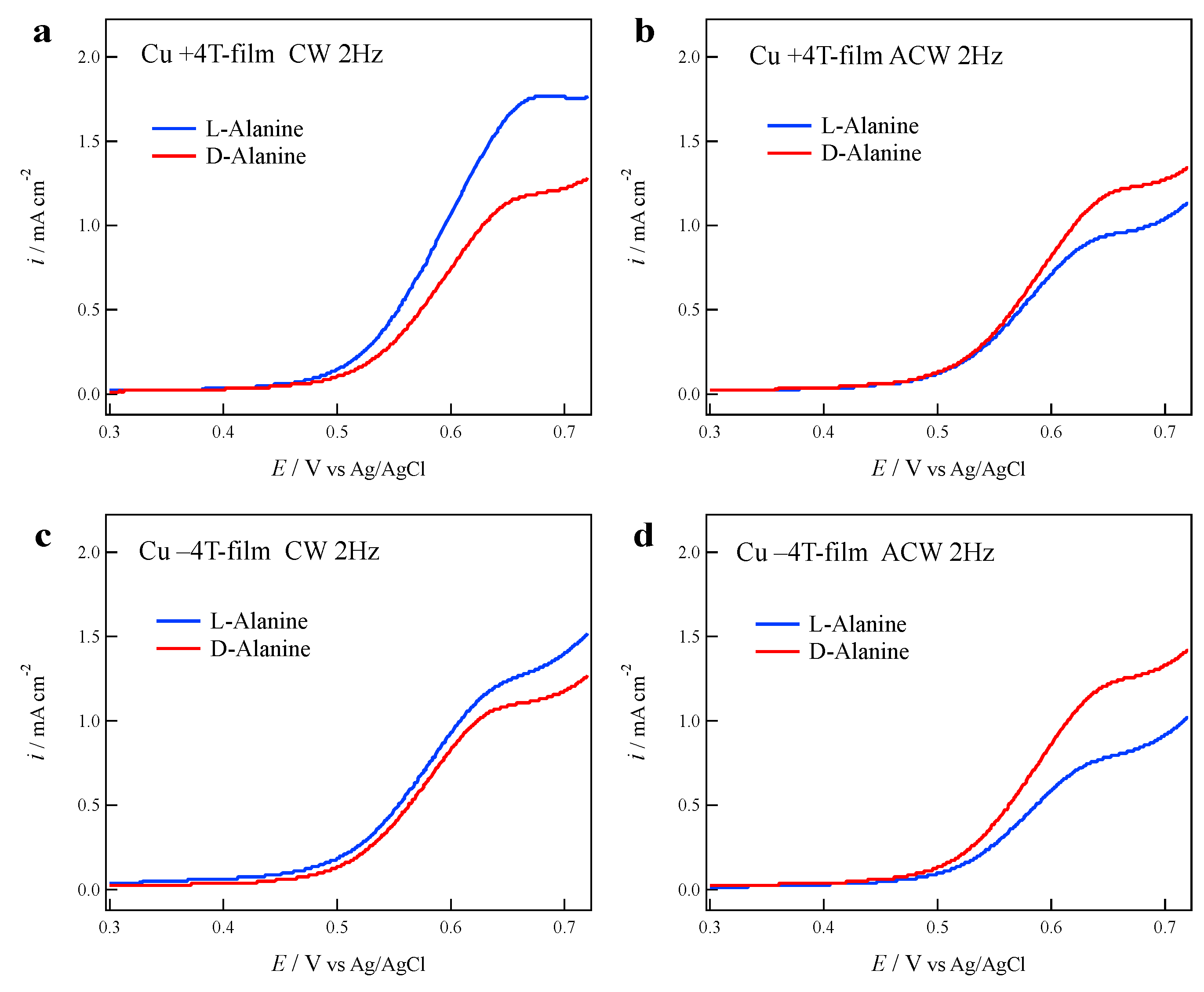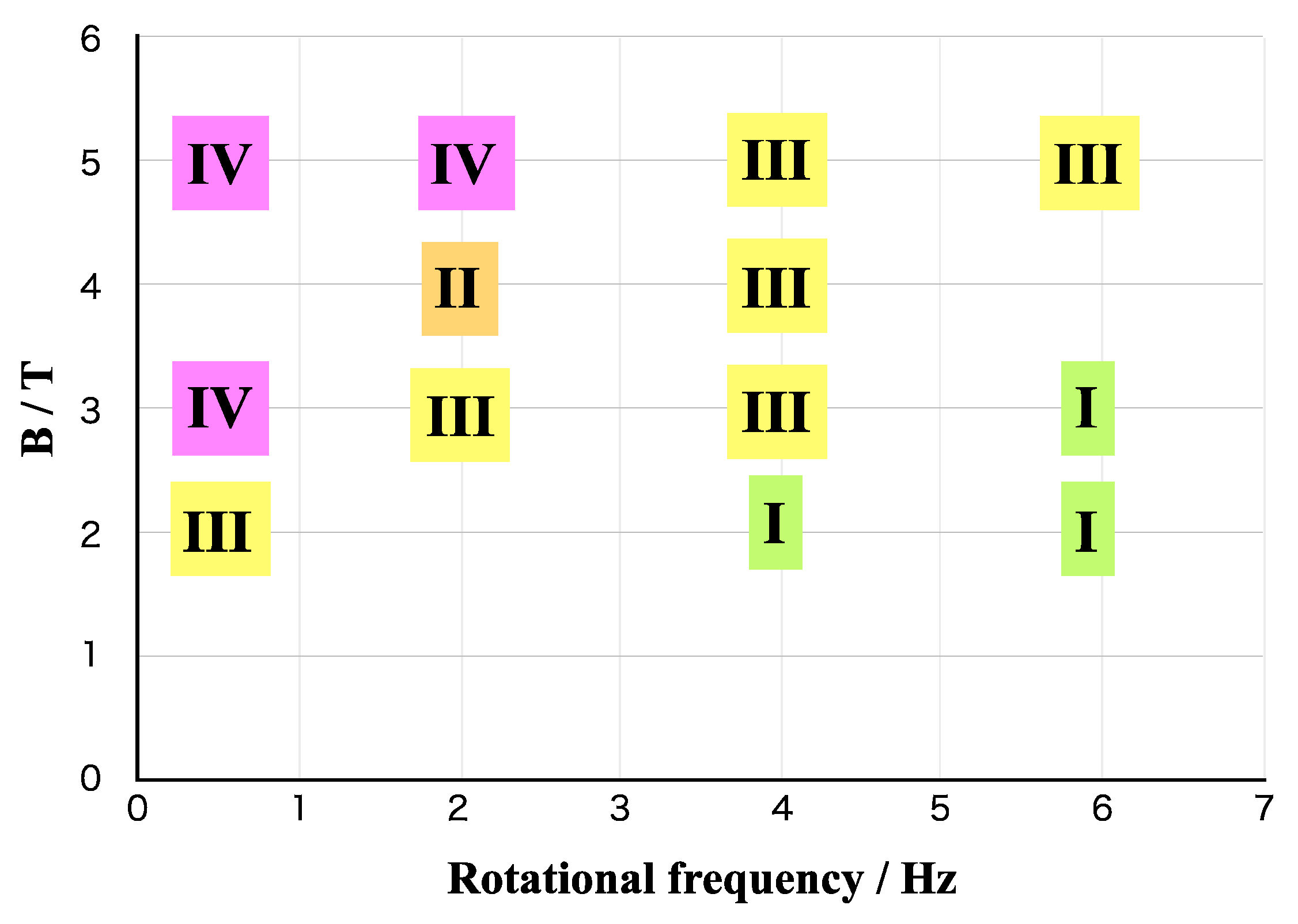Surface Chirality in Rotational Magnetoelectrodeposition of Copper Films
Abstract
1. Introduction
2. Materials and Methods
2.1. Electrochemical Procedures
2.2. RMED Procedures
2.3. Estimation of Surface Chirality
3. Results and Discussion
4. Conclusions
Author Contributions
Funding
Acknowledgments
Conflicts of Interest
References
- Switzer, J.A.; Kothari, H.M.; Polzot, P.; Nakanishi, S.; Bohannan, E.W. Enantiospecific Electrodeposition of A Chiral Catalyst. Nature 2003, 425, 490–493. [Google Scholar] [CrossRef] [PubMed]
- Mogi, I.; Watanabe, K. Chiral Electrode Behavior of Magneto-Electrodeposited Silver Films. ISIJ Int. 2007, 47, 585–587. [Google Scholar] [CrossRef]
- Mogi, I.; Watanabe, K. Chiral Recognition of Amino Acids by Magnetoelectrodeposited Cu Film Electrodes. Int. J. Electrochem. 2011, 239637. [Google Scholar] [CrossRef]
- Mogi, I.; Watanabe, K. Enantioselective Recognition of Tartaric Acid on Magnetoelectrodeposited Copper Film Electrodes. Chem. Lett. 2012, 41, 1439–1441. [Google Scholar] [CrossRef]
- Mogi, I.; Morimoto, R.; Aogaki, R. Surface Chirality Effects Induced by Magnetic Fields. Curr. Opin. Electrochem. 2018, 7, 1–6. [Google Scholar] [CrossRef]
- Gazzotti, M.; Arnaboldi, S.; Grecchi, S.; Giovanardi, R.; Cannio, M.; Pasquali, L.; Giacomino, A.; Abollino, O.; Fontanesi, C. Spin-Dependent Electrochemistry: Enantio-Selectivity Driven by Chiral-Induced Spin Selectivity Effect. Electrochim. Acta 2018, 286, 271–278. [Google Scholar] [CrossRef]
- Kumar, A.; Mondal, P.C.; Fontanesi, C. Chiral Magneto-Electrochemistry. Magnetoelectrochemistry 2018, 4, 36. [Google Scholar] [CrossRef]
- Aogaki, R. Micro-MHD Effect on Electrodeposition in Vertical Magnetic Field. Magnetohydrodynamics 2003, 4, 453–460. [Google Scholar]
- Aogaki, R.; Morimoto, R. Nonequilibrium Fluctuations in Micro-MHD Effects on Electrodeposition. In Heat and Mass Transfer: Modeling and Simulation; Hossain, M., Ed.; InTech: London, UK, 2011; pp. 189–216. [Google Scholar]
- Yanson, Y.I.; Rost, M.J. Structural Accelerating Effect of Chloride on Copper Electrodeposition. Angew. Chem. Int. Ed. 2013, 52, 2454–2458. [Google Scholar] [CrossRef] [PubMed]
- Sommeria, J.; Meyers, S.D.; Swinney, H.L. Laboratory Simulation of Jupiter’s Great Red Spot. Nature 1988, 331, 689–693. [Google Scholar] [CrossRef]
- Marcus, S.M. Numerical Simulation of Jupiter’s Great Red Spot. Nature 1988, 331, 693–696. [Google Scholar] [CrossRef]
- Mogi, I.; Morimoto, R.; Aogaki, R.; Takahashi, K. Effects of Vertical Magnetohydrodynamic Flows on Chiral Surface Formation in Magnetoelectrolysis. Magnetochemistry 2018, 4, 40. [Google Scholar] [CrossRef]
- Mogi, I.; Morimoto, R.; Aogaki, R.; Watanabe, K. Surface Chirality Induced by Rotational Electrodeposition in Magnetic Fields. Sci. Rep. 2013, 3, 2574. [Google Scholar] [CrossRef] [PubMed]
- Luo, P.; Zhang, F.; Baldwin, R.P. Constant Potential Amperometric Detection of Underivatized Amino Acids and Peptides at A Copper Electrode. Anal. Chem. 1991, 63, 1702–1707. [Google Scholar] [CrossRef]
- Mogi, I.; Aogaki, R.; Watanabe, K. Tailoring of Surface Chirality by Micro-Vortices and Specific Adsorption in Magnetoelectrodeposition. Bull. Chem. Soc. Jpn. 2015, 88, 1479–1485. [Google Scholar] [CrossRef]
- Mogi, I.; Aogaki, R.; Takahashi, K. Chiral Symmetry Breaking in Magnetoelectrochemical Etching with Chloride Additives. Molecules 2018, 23, 19. [Google Scholar] [CrossRef] [PubMed]
- Mogi, I.; Aogaki, R.; Takahashi, K. Breaking of Odd Magnetic Field Dependence of Surface Chirality in Magnetoelectrolysis. In Proceedings of the 11th PAMIR International Conference on Fundamental and Applied MHD, Reims, France, 1–5 July 2018; pp. 333–337. [Google Scholar]






© 2019 by the authors. Licensee MDPI, Basel, Switzerland. This article is an open access article distributed under the terms and conditions of the Creative Commons Attribution (CC BY) license (http://creativecommons.org/licenses/by/4.0/).
Share and Cite
Mogi, I.; Morimoto, R.; Aogaki, R.; Takahashi, K. Surface Chirality in Rotational Magnetoelectrodeposition of Copper Films. Magnetochemistry 2019, 5, 53. https://doi.org/10.3390/magnetochemistry5030053
Mogi I, Morimoto R, Aogaki R, Takahashi K. Surface Chirality in Rotational Magnetoelectrodeposition of Copper Films. Magnetochemistry. 2019; 5(3):53. https://doi.org/10.3390/magnetochemistry5030053
Chicago/Turabian StyleMogi, Iwao, Ryoichi Morimoto, Ryoichi Aogaki, and Kohki Takahashi. 2019. "Surface Chirality in Rotational Magnetoelectrodeposition of Copper Films" Magnetochemistry 5, no. 3: 53. https://doi.org/10.3390/magnetochemistry5030053
APA StyleMogi, I., Morimoto, R., Aogaki, R., & Takahashi, K. (2019). Surface Chirality in Rotational Magnetoelectrodeposition of Copper Films. Magnetochemistry, 5(3), 53. https://doi.org/10.3390/magnetochemistry5030053




